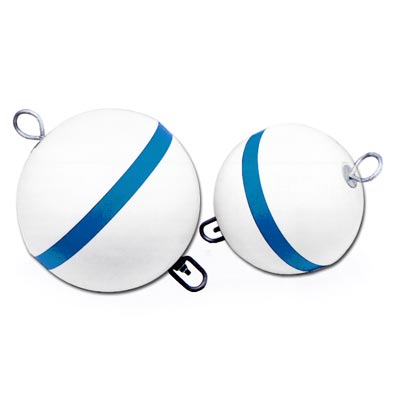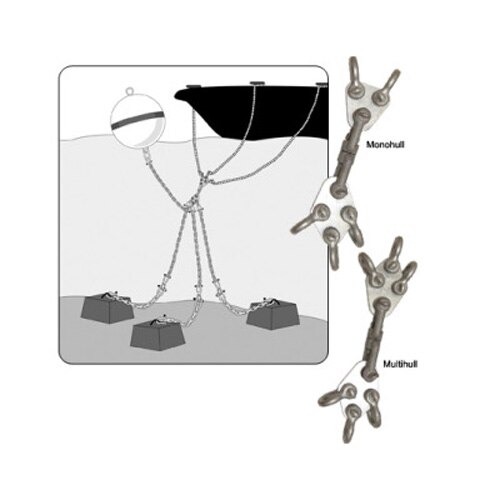When it comes to exploring the coast line, mooring buoys can make it much easier for boaters compared to anchor drops. Instead of worrying about if the anchor will set or not in certain spots, having a mooring buoy allows boaters to explore further with more confidence due to the added safety features. Whether you are sailing around a clear-water shoreline, traversing rocky terrain, or visiting a remote area deep within an unknown bay by boat—mooring buoys offer prime advantages when figuring out where and how best to stop offshore. Read on to find out more about why mooring buoys provide functionality unmatched when hitting those extended destinations!

- What are mooring buoys and their importance for marine exploration: Mooring buoys are an essential tool for marine exploration. These buoys, which are anchored to the bottom of the ocean, serve as a secure point for ships and other vessels to tie up and remain in one place. This is particularly important for researchers who require prolonged access to a specific area for scientific studies. By using mooring buoys, scientists can ensure that their equipment remains in a fixed location and that their experiments are not disrupted by the movement of the vessel. Additionally, mooring buoys help protect fragile ecosystems by preventing vessels from dropping anchor and damaging the sea bed. Overall, the use of mooring buoys is crucial for effective marine exploration and the long-term preservation of our oceans and their inhabitants.
- Benefits of using mooring buoys compared to anchoring: When it comes to docking your boat, there are a few options available to you. You can anchor your vessel, which involves dropping a heavy metal object into the water and hoping it holds you in place. Alternatively, you can use a mooring buoy, which is a large floating ball attached to an anchor that is secured to the ocean floor. There are several benefits to using mooring buoys over anchoring. For one, it’s much easier to secure your boat to a mooring buoy, as you simply attach a line to it. Additionally, mooring buoys are much more environmentally friendly, as they reduce damage to the ocean floor and protect sensitive ecosystems. Finally, there is less chance of your boat drifting away or becoming damaged when using a mooring buoy as opposed to anchoring. Overall, there are several compelling reasons to choose a mooring buoy when docking your boat.
- Safety and practicality when using a mooring buoy. When it comes to mooring buoys, safety and practicality are crucial factors to consider. First and foremost, it’s important to ensure that the type of buoy you choose is suitable for the size and weight of your vessel. Once you have the proper buoy, make sure to attach ropes and chains securely to prevent any accidents or drifting. As for practicality, positioning plays a huge role. It’s essential to select a spot with adequate water depth, away from any hazards such as rocks or other moored boats, and sheltered from strong currents and winds. By prioritizing safety and practicality, you can rest assured that your boating adventure will be a success.
- How to properly set up a mooring buoy. Once you have your mooring buoy in place and the bottom tackle secured, the next step is to attach your boat. Start by tying a line from either your bow or stern cleat to the ring at the bottom of the buoy. If you are using a “floating” mooring system, ensure that the line is long enough for all tide heights. Next, take a longer line and pass it through the eye of the swivel chain link before attaching it to either your bow or stern cleat (depending on which you used for the first line). Make sure this line is snug but not overly tight so that there is still some slack in case of rough seas or strong winds. After both lines are connected, you can double check your work by gently tugging on each of them individually. If everything feels secure, then your boat has been successfully attached to its mooring buoy!
- Locate nearby public or private mooring buoys. If you’re an avid boater, finding a safe and convenient mooring spot is crucial. Luckily, there are plenty of options for locating nearby public or private mooring buoys. A simple online search or browsing a local boating guide can help steer you in the right direction. Some marinas even offer mobile apps that provide real-time information on mooring availability and reservation options. Whether you prefer a public or private mooring, always be sure to properly secure your boat and follow any local regulations to ensure a smooth and stress-free experience on the water.
- Tips for storing your line and buoy during storms. Mooring a boat to a mooring buoy during a storm can be an intimidating prospect for even experienced boat owners. However, with the right preparation and understanding of how to safely secure your craft, you can ensure your safety and protect your vessel from damage.
The first step in preparing for a storm is to properly secure the mooring line to the boat. This involves looping the line around the cleat or other fixtures on board, then tying off on itself or another fixture. The aim is to provide as much tension as possible without allowing any slackness in the line.
Additionally, it’s important to use different lengths for each line; if they are too similar, when one breaks they will both break at once.It’s also important to consider where the buoy is located when deciding how much line should be used. Ideally it should be positioned in calmer waters away from strong currents which may cause it to sway in heavy winds or waves.
Furthermore, make sure there are no obstructions such as rocks that may snag on the line before attaching it securely.Finally, don’t forget about additional safety measures such as extra lines and fenders (bumpers). Fenders will help protect against impacts from passing vessels while extra lines will help ensure that if one of them fails another will remain intact so you can still maintain control of your vessel during severe weather conditions.
The Taylor Made Storm Surge Anchor System is a revolutionary mooring system designed with one purpose in mind: to protect boats from the ravages of storms and turbulent waters. This ingenious design features three anchors that are connected to each other by a special swivel, allowing for maximum flexibility no matter how much the boat turns or tosses. Moreover, up to three lines can be attached between the boat and the anchor, eliminating any risk of chains and lines tangling around each other. This ingenious system ensures stability and security in even the most dangerous conditions, providing peace of mind for those who rely on it.
